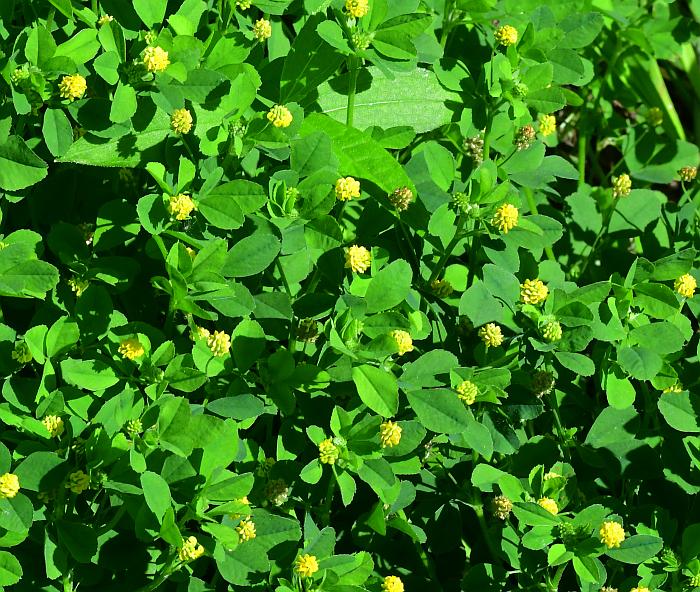Medicago lupulina L.
Black Medick

Introduced
CC = *
CW = 3
MOC = 66
© SRTurner
Medicago lupulina L.Black Medick | |
 |
Introduced CC = * CW = 3 MOC = 66 |
© SRTurner |
|
Family - Fabaceae/Faboideae Habit - Annuals or biennial forb with shallow, slender taproots. Stems - Prostrate to loosely ascending, to 60 cm, sometimes from a spreading base, often mat-forming or low mound-forming, glabrous or more commonly sparsely to moderately pubescent with fine, upward-curved to loosely appressed, nonglandular hairs and often also shorter, spreading, gland-tipped hairs. Stem usually 4-angled near the tips.
Leaves - Alternate, petiolate, stipulate, trifoliate. Stipules 5-8 mm long, the margins entire or more commonly shallowly toothed, fused to the petiole at or below the midpoint. Petiolule of terminal leaflet to 4 mm; those of lateral leaflets shorter or absent. Leaflets 5-18 mm long, 2.5-15.0 mm wide, obovate to broadly obovate, oblong-obovate, elliptic, or nearly circular, more or less rounded at the tip, usually with a noticeable, triangular, sharply pointed tooth at the very tip, the upper surface glabrous or nearly so, lacking a red or purple spot, the undersurface sparsely to moderately pubescent with loosely appressed hairs and sometimes also shorter, spreading, gland-tipped hairs. Lateral venation parallel.
Inflorescences - Dense racemes, appearing as headlike clusters, more or less globose to ovoid at flowering, becoming somewhat elongated and short-cylindric at fruiting, with 10-30 flowers, extending beyond the subtending leaves. Peduncles 20-45 mm long, longer than the subtending leaf, pubescent.
Flowers - Calyces with the tube 0.4-0.6 mm long, the lobes 0.6-1.0 mm long. Corollas 2-3 mm long, papilionaceous, yellow. Banner to 3 mm broad, mostly glabrous, typically with apical margins revolute. Keels apically fused. Wings connate basally to keels. Stamens diadelphous. Filaments with the fused portion 0.5-0.7 mm long, the free portion 0.1-0.3 mm long. Style short, green.
Fruits - Single-seeded legumes, 2.5-3.0 mm long, kidney-shaped, curved but not spirally coiled, longitudinally wrinkled, strongly nerved, glabrous or occasionally with scattered, gland-tippedhairs, black at maturity.
Flowering - February - December. Habitat - Streambanks, forest openings, prairies, glades, pastures, levees, lawns, farmyards, crop field margins, railroads, roadsides, open, disturbed area. Origin - Native to Eurasia and Africa. Lookalikes - Trifolium campestre, Trifolium dubium. Other info. - This little introduced species is widely distributed, probably occurring in every Missouri county as well as every state in the continental U.S. It is recognized by its very small, headlike clusters of yellow flowers and its trifoliate leaves. It can be confused with the yellow-flowered clovers, but can be reliably distinguished by its squarish upper stems. The plant spreads easily and can form large colonies when left untouched. The small fruits of this plant turn black when ripened and look like small kidneys. The plants fix nitrogen, increasing soil fertility, and are a protein-rich, nutritious fodder for livestock and other grazing ruminants. The flowers are utilized by honeybees, and the tiny fruits are a food source for many birds. Photographs taken in Ellington, MO., 6-3-01, and in Gainesville, FL., 2-11-03 (DETenaglia); also along the Katy Trail near Marthasville, Warren County, MO, 5-9-2020, and at Shaw Nature Reserve, Franklin County, MO, 6-5-2021 (SRTurner). |